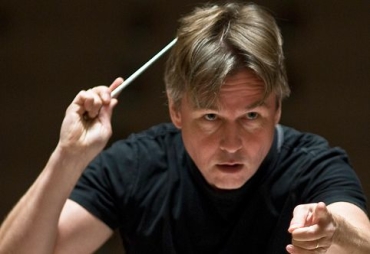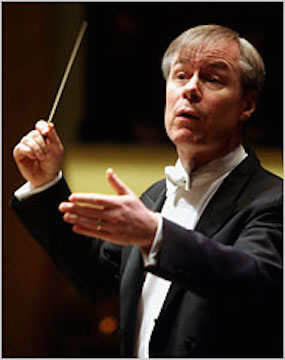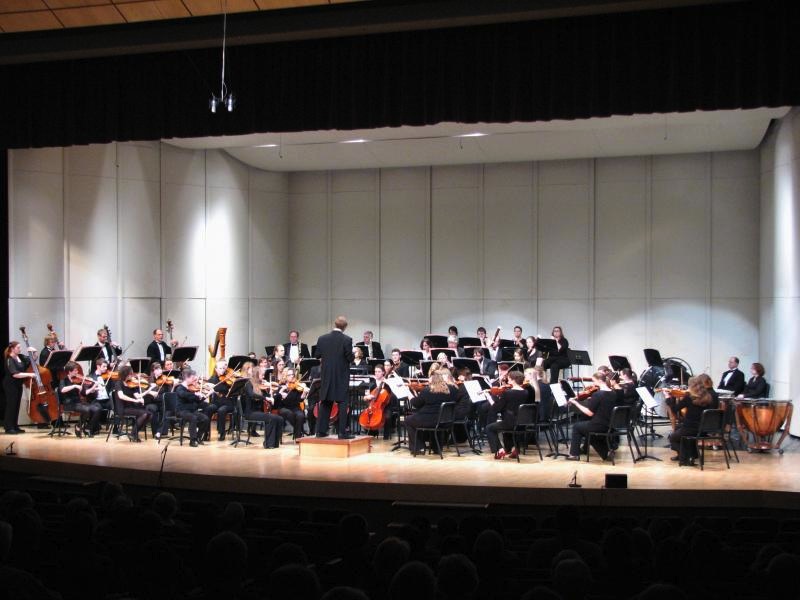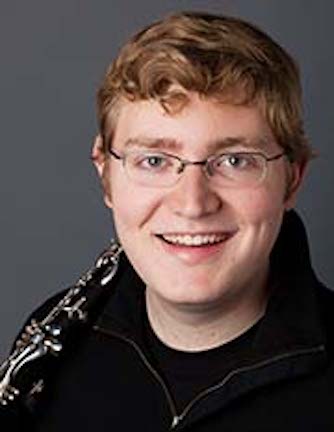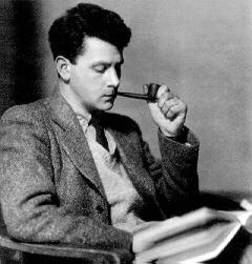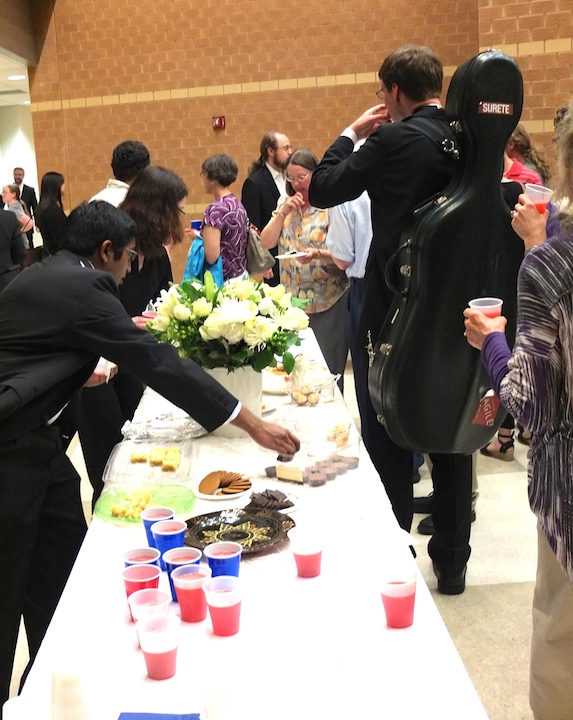The Well-Tempered Ear
Classical music: Why couldn’t the New York Philharmonic find an American conductor? Meet Dutchman Jaap van Sweden, its next music director. Plus, Sunday Afternoon Live From the Chazen, is NEXT SUNDAY — NOT TODAY — and tonight’s concert of new music by UW-Madison professor Les Thimmig has been CANCELLED
4 Comments
ALERT 1: The Sunday Afternoon Live performance by the Wisconsin Brass Quintet at the Chazen Museum of Art is NEXT SUNDAY, NOT TODAY. The Ear apologizes for the mistake.
ALERT 2: Tonight’s concert of new music for woodwinds and piano by UW-Madison professor Les Thimmig and pianist Jessica Johnson has been CANCELLED.
By Jacob Stockinger
This week the New York Philharmonic announced its next music director and conductor who will succeed Alan Gilbert, starting in 2018.
He is Jaap van Sweden (below, in a photo by Todd Heiser for The New York Times , a 55-year-old Dutchman, acclaimed for his technical prowess, who now is the music director of the Dallas Symphony Orchestra and the Hong Kong Philharmonic.
There are a lot of stories The Ear could link to.
Here is a short summary from NPR (National Public Radio) with audio clips of his conducting:
But he found the coverage by the New York Times quite comprehensive and, on balance, fair.
It featured a main news story with some important feature elements, including the critical acclaim van Sweden received for conducting music by Gustav Mahler and Ludwig van Beethoven. (Below, you can see van Sweden conducting the New York Philharmonic in 2014 in a photo by Hiroyuki Ito for The New York Times).
And it also featured a column or commentary by senior classical music critic Anthony Tommasini, who spoke in Madison on the occasion of the centennial of the Pro Arte Quartet that was held at the University of Wisconsin-Madison School of Music.
Overall, Tommasini’s notebook entry is a fine and insightful piece, even if it gets tiring to hear Tommasini climb up on his high horse and whine yet again about the neglect of new music and contemporary composers – which does not seem fully justified based on the record of this particular conductor.
Tommasini – who himself was trained as a composer — clearly would have preferred former Los Angeles Philharmonic conductor and composer Esa-Pekka Salonen (below) as the new music director and conductor. Hmmm – could they be friends?
For his part, it may sound provincial but The Ear is more concerned that the very same symphony orchestra that made history in American culture for hiring the first American-born and American-trained maestro – Leonard Bernstein (below), who also just happened to put Jaap van Sweden on the path to a conducting career – is once again turning to Europe rather to the many fine conducting talents in this country.
Why was no American conductor chosen. One who comes to mind is Marin Alsop of the Baltimore Symphony Orchestra (below top) and the Sao Paulo State Symphony Orchestra in Brazil who is also a Bernstein protege. And then there is David Robertson of the St. Louis Symphony Orchestra and chief conductor of the Sydney Symphony Orchestra in Australia(below bottom).
Seems odd that Marin Alsop is good enough for Brazil and David Robertson is good enough for Australia — but not for New York?
The Ear wants to ask the Philharmonic’s board of directors: Do you really find all American conductors to be that inferior to Jaap van Sweden?
Maybe there were practical considerations — salary, contracts, availability, refusals — that made hiring an American conductor impossible. But the stories suggest that the choice of van Sweden was made early on and the fix seemed in. Too bad. It still seems like a great opportunity that was lost.
You can decide for yourself.
Here is the news story by Michael Cooper:
And here is Tommasini’s column:
Do you know the work of Jaap van Sweden?
Have you heard him in live or recorded performances?
What do you think?
Here is a sample of Jaap van Sweden conducting Beethoven’s Symphony No. 7 in a YouTube video at the bottom.
Leave your opinion in the COMMENT section.
The Ear wants to hear.
Tags: Alan Gilbert (conductor), Arts, Australia, Baltimore, Baltimore Symphony Orchestra, Beethoven, Brazil, China, Classical music, Dallas, Dallas Symphony Orchestra, David Robertson, Esa-Pekka Salonen, Gustav Mahler, Hong Kong, Hong Kong Philharmonic, Jaap van Sweden, Jacob Stockinger, Leonard Bernstein, Los Angeles, Los Angeles Philharmonic, Ludwig van Beethoven, Madison, Marin Alsop, Music, National Public Radio, New Music, New York City, New York Times, NPR, Orchestra, Pro Arte Quartet, Sao Paulo, Sao Paulo State Symphony Orchetsra, St. Louis Symphony Orchestra, Sydney, Sydney Symphony Orchestra, Symphony No. 5 (Beethoven), Symphony No. 7, Texas, The New York Times, United States, University of Wisconsin-Madison School of Music, University of Wisconsin–Madison, Wisconsin, YouTube
Classical music: Why is Beethoven so popular? And why do all-Beethoven concerts work so well? Conductor Andrew Sewell answers these questions even as he prepares to perform the all-Beethoven concert tonight by the Wisconsin Chamber Orchestra.
2 Comments
By Jacob Stockinger
Tonight at 8 p.m. in the Capitol Theater of the Overture Center, conductor Andrew Sewell (below top) will lead the Wisconsin Chamber Orchestra (below bottom) and guest pianist Bryan Wallick, who won the Vladimir Horowitz Prize and is returning to Madison, in an all-Beethoven concert to wrap up this season of the WCO indoors Masterworks programs.
The program includes the “Leonore” Overture No. 1, the Piano Concerto No. 5 “Emperor” and the Symphony No. 7.
Tickets are $15-$62. For more information, visit: http://www.wcoconcerts.org/performances/masterworks-v
The Ear asked the guest pianist Bryan Wallick and WCO’s longtime music director and conductor Andrew Sewell to explain why all-Beethoven concerts work so well and why Beethoven remains so popular with the general public. (Coincidentally, the Madison Symphony Orchestra will also close its season with Beethoven, specifically the Symphony No. 9 (“Choral” or “Ode to Joy”) on May 8, 9 and 10.
Wallick’s answers appeared here on Wednesday and offered the perspective of an instrumentalist. Here is a link to his answers:
And here are the answers by conductor Andrew Sewell (below), who kindly responded to an email Q&A:
Beethoven (below), along with a handful of other composers, including Mozart and Tchaikovsky, is one of the few composers who can make up a single-composer concert that also attracts the public. What accounts for that, do you think?
I think his name is synonymous with classical music. His music defines it — the working out of themes, melody and development — from his overtures, symphonies, concertos, piano sonatas and string quartets.
What role has Beethoven played in your career? Are there works in particular that you were drawn to as a student or a performing professional?
As a young concertgoer, at the age of 8, I heard his Symphony No. 9 “Choral” and fell in love with the “Ode to Joy.” I was captivated by his life and biography, about his deafness overtaking him, and stories of his inner personal struggles. I remember reading all about his life as a youngster, and I loved playing his music.
As a violinist, I loved getting to know his violin sonatas and symphonies. One of my first significant orchestral experiences at age 16 was playing his “Leonore” Overture No. 3 with the New Zealand Youth Orchestra, and a year later, the Fifth Symphony. Beethoven’s overtures and symphonies are the bread and butter of any orchestra.
Beethoven consistently ranks as the general public’s favorite classical composer. Why is that, do you think? The consistently high quality of the music? The diversity of works and forms that his creativity expressed itself in? The sense of overcoming struggle and personal hardship you find in his works?
All of the above. You said it in the wide variety of forms he used –- symphonies, overtures, sonatas, chamber music. The string quartets alone, like Mozart’s Piano Concertos, are a lifetime testament in which we see his development as a composer and inner struggles.
His personal life is intertwined with the complexities of his later works, as he stretched the boundaries of form and development. His Ninth Symphony and the late string quartets testify to this. Overcoming struggle and personal hardship give the music its triumphal drive.
Is there an aspect of Beethoven that you think the public needs to pay more attention to and that you intend to emphasize in your interpretations?
The “Leonore” Overture No. 1 is probably the least played of the four overtures related to his one and only opera, “Fidelio.” Inadvertently he created a new form, known as the Concert Overture, and which Mendelssohn later took up.
This overture, does not include the off-stage trumpet reverie, as in Nos. 2 and 3. For some reason, Beethoven was not satisfied, and continued to refine it in later compositions. What I find intriguing about this overture is the way he transitions from slow to fast sections and back again so seamlessly and how he experimented with a continuous form.
The Symphony No. 7 — below is a page of the work’s manuscript from Beethoven’s almost illegible notebooks — is among his most energetic symphonies. It never lets up and is physically demanding on all sections of the orchestra. One needs stamina for this music. It is also extremely exciting to play and to listen to, hence it is a very popular symphony. (At the bottom, in a popular YouTube video with almost 8 million hits, you can hear the famous and well-known Allegretto movement from the Symphony No. 7 with an intriguing bar graph score.)
Is there anything you would like to say or add?
An all-Beethoven program is a great way to end the season, especially when you have pianist Bryan Wallick (below) returning to perform with us. We are most excited to hear and share his performance of the mighty “Emperor” Piano Concerto.
Tags: Andrew Sewell, Arts, Beethoven, Bryan Wallick, Chamber music, choral music, Choral Symphony, Classical music, concerto, development, Emperor Concerto, Fidelio, Fifth Symphony, Jacob Stockinger, Leonore Overture No. 1, Ludwig van Beethoven, Madison, melody, Mozart, Music, New Zealand, Ode to Joy, opera, Orchestra, Overture, Piano, Piano concerto, Piano Concerto No. 5 (Beethoven), Piano sonata, Sonata, String quartet, string quartets, Symphony No. 7, Symphony No. 9 (Beethoven), Tchaikovsky, theme, University of Wisconsin-Madison School of Music, University of Wisconsin–Madison, Violin, Wisconsin Chamber Orchestra, Wolfgang Amadeus Mozart, YouTube
Classical music: On Monday night, the Middleton Community Orchestra, with Madison Symphony Orchestra clarinetist Joe Morris as soloist, offers a holiday break from holiday music with works by Brahms, Gerald Finzi and Beethoven.
1 Comment
By Jacob Stockinger
Thank you, Middleton Community Orchestra.
Surely The Ear can’t be the only person who is starting to feel unpleasantly overwhelmed with holiday music — to say nothing of holiday shopping and holiday cards, with holiday this and holiday that.
Holiday music seems ever-present this time of the year. It is in stores and malls, on the radio and TV, in the churches and even in the many concert halls. And it has been going on for weeks, if not months.
So coming into the home stretch of Christmas Week, The Ear is feeling particularly grateful to the Middleton Community Orchestra (below), a largely amateur group that also includes some very accomplished professionals.
The MCO rarely, if ever, disappoints me. But this upcoming concert, which is NOT billed as a “holiday” concert, seems especially inviting since it promises to offer the gift of music –- not just holiday music, but real music.
Coming into Christmas Week, I find this to be a very welcome offering, a pitch perfect program.
The concert not only features terrific music but also the right length at the right cost, and includes some post-concert meet-and-greet socializing so you can meet the musicians and other audience members.
Here is the announcement from MCO co-founders Mindy Taranto and Larry Bevic:
The Middleton Community Orchestra’s December concert is this coming Monday, Dec. 22, at 7:30 p.m. at the Middleton Performing Arts Center, which is attached to Middleton High School, at 2100 Bristol Street, a simple right turn off University Avenue going west towards the Beltline a few blocks before Parmenter Street.
The MCO is excited to be sharing the stage with Madison Symphony Orchestra principal clarinetist Joe Morris (below top) who will be performing the Concerto for Clarinet and Strings by the 20th-century English composer Gerald Finzi.
You’d be counting down the days if you have heard Joe play (below top, in a photo by Cheryl Savan), and the work by Gerald Finzi (below bottom) is a beautiful piece through which Joe’s amazing clarinet playing soars.
Don’t miss the chance to hear Joe, the MCO and this beautiful concerto. How many 24-year-olds do you know who have won an audition from among 60 other clarinettists vying for the job? Come hear one of our local treasures.
The concert will be conducted by Middleton High School music teacher Steve Kurr (below).
The program starts with the popular and rousing “Academic Festival Overture” by Johannes Brahms (below), which uses tunes from German drinking songs and which Brahms composed to celebrate an honorary degree he received.
Then, after the lovely Finzi concerto, please stay so you can experience the irresistible energy and drive of Symphony No. 7 by Ludwig van Beethoven (below), which concludes the program. It is many people’s favorite Beethoven symphony and was highly thought of by the composer and other famous composers including Richard Wagner who famously called it “the apotheosis of the dance” because of its lively rhythms.
(By the way, the well-known and haunting slow movement featured prominently in the Oscar-winning film “The King’s Speech” several years ago. You can hear it at the bottom in a popular YouTube video.)
We hope to see you Monday. Tickets are $10, with students admitted free of charge. Advance tickets are available at Willy Street Coop West or at the door on the night of the show starting at 7 p.m. You can also call (608) 212-8690 to reserve tickets in advance.
There will be a reception (below) for the audience and musicians after the concert.
For information about the Middleton Community Orchestra, including how to support it and how to join it, here is a link to its website:
http://middletoncommunityorchestra.org
Tags: Academic Festival Overture, Arts, Beethoven, British music, Chamber music, Christmas, Christmas music, clarinet, Classical music, concerto, England, English, Gerald Finzi, German music, Germany, Great Britain, Holiday, holiday music, holiday season, Jacob Stockinger, Johannes Brahms, King, Ludwig van Beethoven, Madison, Madison Symphony Orchestra, Middleton Community Orchestra, Music, Orchestra, Richard Wagner, symphony, Symphony No. 7, The King's Speech, University of Wisconsin-Madison School of Music, University of Wisconsin–Madison, Violin
Classical music: It’s time to go back to the future. The classical music scene needs more professional groups to act like the Middleton Community Orchestra and break down barriers between performers and listeners.
5 Comments
By Jacob Stockinger
There was a time when no professional symphony orchestras existed, at least outside of royal courts. Even Ludwig van Beethoven had to hire freelance pick-up orchestras to premiere his monumental and iconic symphonies and concertos.
That meant that classical music was much more of a home activity and much more of a community affair that it usually is today.
But there are exceptions.
I was reminded of that on Wednesday night when – in the Middleton Performing Arts Center that is attached to Middleton High School — I attended the concert that closed the fourth season of the Middleton Community Orchestra (below).
As I sat there, I realized I was simultaneously getting a glimpse of both the past and the future of classical music, which is under siege and needs some new strategies to thrive and prevail if it is to attract new and younger audiences.
I have written before about why I like the Middleton Community Orchestra so much.
Here is a link to a 2012 review with the nine reasons why I like them and think you should too:
But this most recent concert only deepened and expanded those convictions.
So here are some of my more recent thoughts, not necessarily deep but perhaps helpful and even insightful:
First and foremost, I liked the way the barriers between the performers and the audience members were broken down. I took some photos of what I saw: brass and string players talking with friends, family members, admirers and strangers both before the concert, during the intermission and then during the social dessert reception after the concert.
It all made the act of music-making seem more humane, more do-able, more central to daily life. Music seemed a cohesive bond for the entire community.
I also liked that the community orchestra –- which used some professional members but also many amateur musicians — once again turned in convincing readings of great music.
And they did so by once again spotlighting local talent.
One was pianist and Middleton native, Thomas Kasdorf, who did his undergraduate work at the University of Wisconsin-Madison School of Music and who returns there in the fall for a graduate degree.
Kasdorf (below) gave an absolutely thrilling and gorgeous reading of Edvard Grieg’s popular Piano Concerto in A Minor, Op. 16. Here is a link to an interview The Ear did with him:
Kasdorf played with dynamism and lyricism, drawing a big sound out of the smaller-than-concert grand Steinway. He captured the many moods and beautiful tunes, the infectious rhythms, the long and songful phrases, and the stirring harmonies of Grieg’s evergreen concerto.
Not everyone agreed. Here is critic John W. Barker’s dissent for Isthmus:
http://www.thedailypage.com/music/article.php?article=42912
No less than pianist-composer Sergei Rachmaninoff (below) told Arthur Rubinstein that the Grieg Piano Concerto was the best and most effective piano concerto ever composed. And Rachmaninoff, who himself used the Grieg as a model, knew a thing or two about composing and performing piano concertos.
Kasdorf wasn’t alone in excelling.
UW-Madison graduate violist Alice Bartsch (below) also turned in a sublime and moving reading of Antonin Dvorak’s soaringly lyrical Romance in F Minor, Op. 11, for Violin and Orchestra. It was all the more moving because it was her last concert as concertmaster of the MCO before she moves on to a professional job. (You can hear Dvorak’s lovely Romance at the bottom in a popular YouTube video. Tell me it doesn’t make you want to hear more of the tuneful Dvorak’s music.)
In fact, conductor Steve Kurr, who teaches at Middleton High School, also recognized other members of the orchestra who were moving on after this valedictory concert and asked them to stand up for applause — which they received:
I also loved the audience. I don’t know them by name, but enough people were there that the house seemed plenty full. Moreover, many of the listeners were very young or looked like people you don’t usually see at events like the Madison Symphony Orchestra or the Wisconsin Chamber Orchestra.
Well, one reason is that the price is right. WCO admission has two prices: $10 for adults and free for students. At that level, who can’t afford to take a chance? It might be nice if bigger groups tried cutting costs instead of increasing them. Affordability begets accessibility, The Ear suspects.
The orchestra, of course, also played on its own. It gave a respectable and at times moving reading to Sir Edward Elgar’s ambitious musical portraits in the “Enigma” Variations. As happened in also in the Grieg, I found especially the brass and percussion outstanding, though all sections, and especially the strings and winds, also held their own and had much to be proud of.
That’s not to say there weren’t mistakes or lapses or shortcomings. But, hey, this isn’t the Berlin Philharmonic. Besides, imperfection is an inherent part of most performing arts. But the orchestra clearly communicated the music’s emotion to the audience, and that is what matters most.
The concert finished with the suite of three dances from Spanish composer Manuel de Falla’s ballet score for “The Three-Cornered Hat.”
And there was my one criticism.
I am afraid the MCO has unfortunately expanded to imitate more professional organizations. I prefer the 90-minute, no intermission format. I think that could have been done if they had programmed this way: open with the Dvorak Romance; then do the Grieg Piano Concerto; and then finish with the Elgar Variations. (By my reckoning that would add up to about 85 minutes of music, with time left over for some stage changes.)
This concert was just a bit too long. People were tired, especially on a weekday night. And beside, it is nice to get in The Zone and then leave The Zone –- and not try to renter the Zone after intermission. It is also nice to get back home early when work is facing you the next day.
Then came the FREE desserts and the chat between hungry musicians and hungry audience members.
But it seemed everyone left with their appetite for music satisfied.
So congratulations then to the MCO co-founders Mindy Taranto and Larry Bevic plus conductor Steve Kurr. Over four seasons, they have grown an experimental project into a new tradition that seems to be attracting more people who appreciate them -– as you could tell from the cheers and hearty applause and prolonged standing ovations.
Next season promises very good things: Beethoven’s Symphony No. 7 and Dvorak’s Symphony No. 8; Rachmaninoff’s Symphonic Dances and Modest Mussorgsky’s “Pictures at an Exhibition”; the famous “William Tell” Overture (the “Lone Ranger” theme) by Giacchino Rossini and the Academic Festival Overture and Tragic Overture by Johannes Brahms; plus Thomas Kasdorf again in the great Piano Concerto No. 1 by Tchaikovsky (with, three cheers, Thomas Kasdorf as soloist in what The Ear jokingly calls the Van Cliburn Piano Concerto No. 1) and more.
It is something to look forward to.
All that music and all that fun for all that affordability.
See you then, see you there!
Tags: Academic Festival Overture, Antonín Dvořák, Arthur Rubinstein, Arts, Beethoven, Classical music, concerto, conductor, Dvorak, Edvard Grieg, Edward Elgar, Enigma Variations, Grieg, Jacob Stockinger, Johannes Brahms, Ludwig van Beethoven, Madison Symphony Orchestra, Manuel de Falla, Middleton Community Orchestra, Middleton High School, Modest Mussorgsky, Music, Mussorgsky, Orchestra, Piano, Piano concerto, Pictures at an Exhibition, Rachmaninoff, Romance, Rossini, Rubinstein, Sergei Rachmaninoff, symphony, Symphony No. 7, Tchaikovsky, Tchaikowsky, Thomas Kasdorf, United States, University of Wisconsin-Madison School of Music, University of Wisconsin–Madison, Van Cliburn, Violin, William Tell Overture, Wisconsin Chamber Orchestra, YouTube










